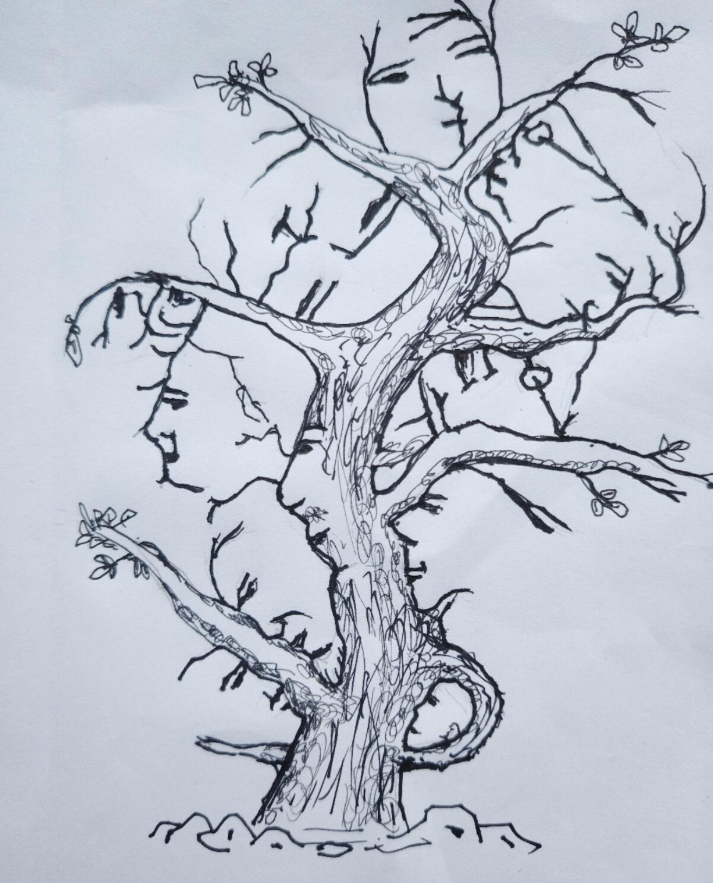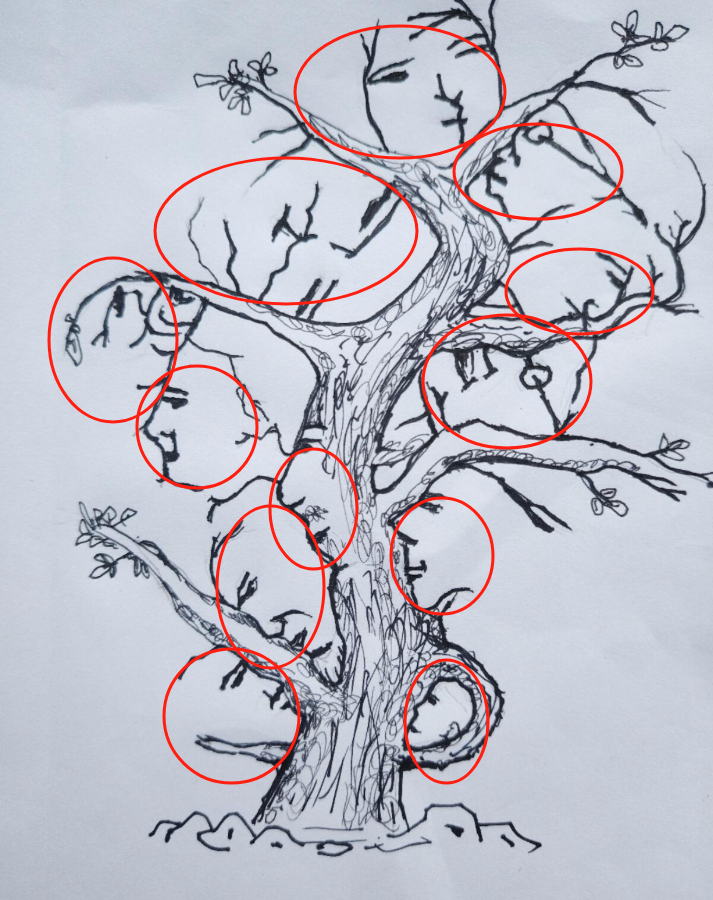Unearthing Faces in the Forest: The Enigmatic Allure of the ‘Tree of Faces’ Drawing
Introduction
Have you ever glanced at a swirling knot of branches and suddenly spotted a hidden profile staring back at you? That delightful trick of the mind, known as pareidolia, transforms ordinary trees into living portraits. In the hand-drawn sketch before us, each twist of the trunk and every sprig of foliage unfolds into human faces—some serene, some contemplative, all mysteriously intertwined. Let’s explore why this ‘Tree of Faces’ captures our imagination, unpack the psychology behind it, and even learn how you can create your own forest full of secret portraits.

The Magic of Seeing Faces in Nature
Why do we see faces where they don’t actually exist? From cloud formations to rock faces, our brains are wired to detect human features. Evolutionarily, spotting a face quickly meant recognizing a friend—or a foe. Today, that same wiring delights us with surprise when a tree’s gnarled bark morphs into a nose or an ear. This sketch amps up the effect, deliberately weaving profiles into every limb and branch. It’s a playful tug-of-war between reality and illusion, inviting us to look twice and grin at our own perceptiveness.
Diving into Pareidolia: Your Brain’s Built-In Puzzle
Pareidolia isn’t just a quirky party trick; it’s a window into how our minds organize sensory input. When faced with chaotic or ambiguous patterns, your brain automatically seeks familiar shapes—particularly faces. In this drawing, the artist leverages that instinct, offering just enough detail—a curve here, a shadow there—to trigger face-recognition pathways. Once one profile emerges, it’s like unlocking a hidden level: you’re hooked, scanning branches for more concealed visages. It’s a cognitive treasure hunt with no finish line.

Artistic Techniques for Crafting the Tree of Faces
Capturing hidden faces in a tree requires a deft balance of suggestion and subtlety. Here’s how the magic happens on paper:
- Line Variation: Notice thicker strokes outlining the trunk and thinner lines in the branches. That contrast gives depth, letting some profiles stand out while others recede.
- Negative Space Mastery: By leaving certain areas blank—between twigs or in leaf clusters—the artist forms noses, brows, and lips without ever drawing them explicitly.
- Selective Detail: Key facial landmarks (eyes, mouth, chin) appear sparingly. Your mind fills in the rest, completing the portrait with minimal cues.
- Organic Flow: Branches curve like cheeks or brows, guiding your gaze from one face to the next as though the tree itself is breathing.

Emotional Resonance: Why Face Trees Captivate Our Hearts
Beyond the visual puzzle, there’s an emotional pull to this fusion of human and arboreal forms. Trees symbolize wisdom, resilience, and connection to the earth. Faces evoke empathy, recognition, and social bonds. When you merge the two, you get an artwork that feels alive—like ancestral spirits whispering through leaves. Some faces in the sketch seem joyful, others pensive, creating a tapestry of moods that mirror our own emotional spectrum. Engaging with this drawing becomes a moment of self-reflection: which faces feel familiar, and why?
How to Create Your Own ‘Tree of Faces’ Masterpiece
Feeling inspired? You can craft your own secret-face forest with a few simple steps:
- Start with a Basic Tree Trunk
Sketch a sturdy trunk and major branches in pencil. Focus on fluid, natural curves rather than straight lines. - Map Out Face Silhouettes
Lightly draw profile outlines along branches—nose to chin, forehead to lip. Keep them varied in size and orientation for visual interest. - Blend Details and Ambiguity
Ink over your pencil, accentuating only key features: an eye here, a mouth there. Erase stray pencil marks, leaving some faces more hidden than others. - Add Leaves and Knots
Fill the spaces around faces with foliage, bark texture, and knots. Use cross-hatching for shading, letting shadows hint at cheekbones or brows. - Step Back and Discover
Take breaks to return with fresh eyes. You’ll spot new faces each time—then tweak details to heighten the surprises.

Using Face Trees as Mindful Art Therapy
Creating—or simply studying—a ‘Tree of Faces’ can be a powerful mindfulness exercise. As you trace each branch and uncover hidden portraits, your focus shifts away from stress and into present-moment curiosity. This gentle flow state reduces anxiety, sparks creativity, and fosters self-awareness. Try dedicating ten minutes each day to sketching or coloring a face-filled tree, noticing how your thoughts and mood evolve with every line.
Displaying Your Art: From Sketchbook to Wall
Once your ‘Tree of Faces’ drawing is complete, why keep it hidden? Here are a few display ideas:
- Framed Wall Art: A black frame and white matte amplify the sketch’s contrast, turning it into a conversation-starting focal point.
- Customized Wallpaper: Digitize your drawing and print it as a small-batch wallpaper—perfect for a cozy reading nook or meditation corner.
- Fabric Prints: Transfer the image onto throw pillows or tote bags, letting hidden faces accompany you through daily life.

Conclusion
The ‘Tree of Faces’ sketch is more than an art piece—it’s an invitation to see the extraordinary in the ordinary. By tapping into our natural tendency for pareidolia, the artist crafts a living puzzle that delights the mind, stirs the heart, and awakens our creative spirit. Whether you’re unraveling its subtle profiles or sketching your own hidden-face forest, this art form reminds us that magic truly lurks in plain sight. So next time you’m strolling through a grove or flipping through old notebooks, keep your eyes—and your imagination—wide open. You never know which friendly face might emerge from the bark.





